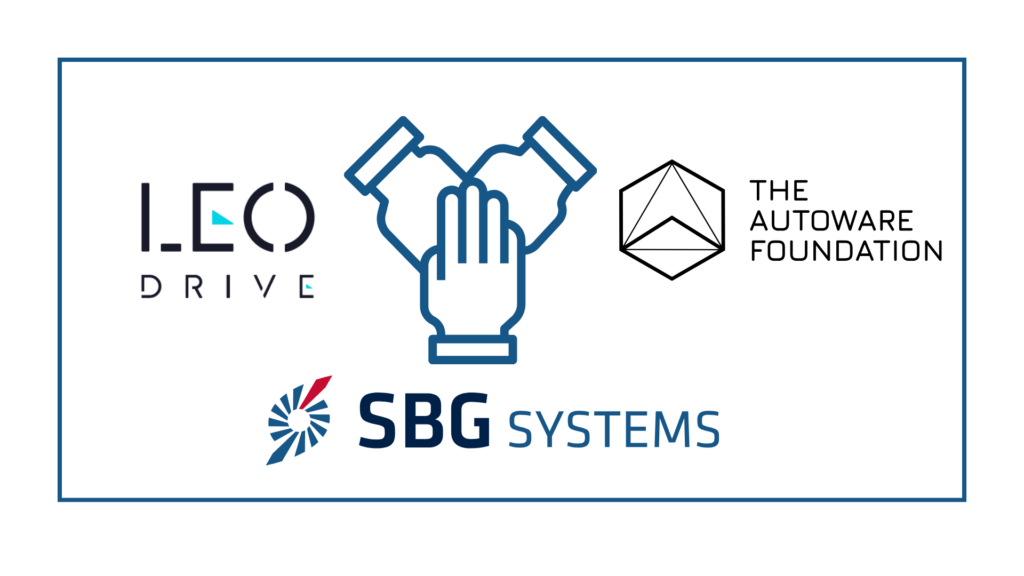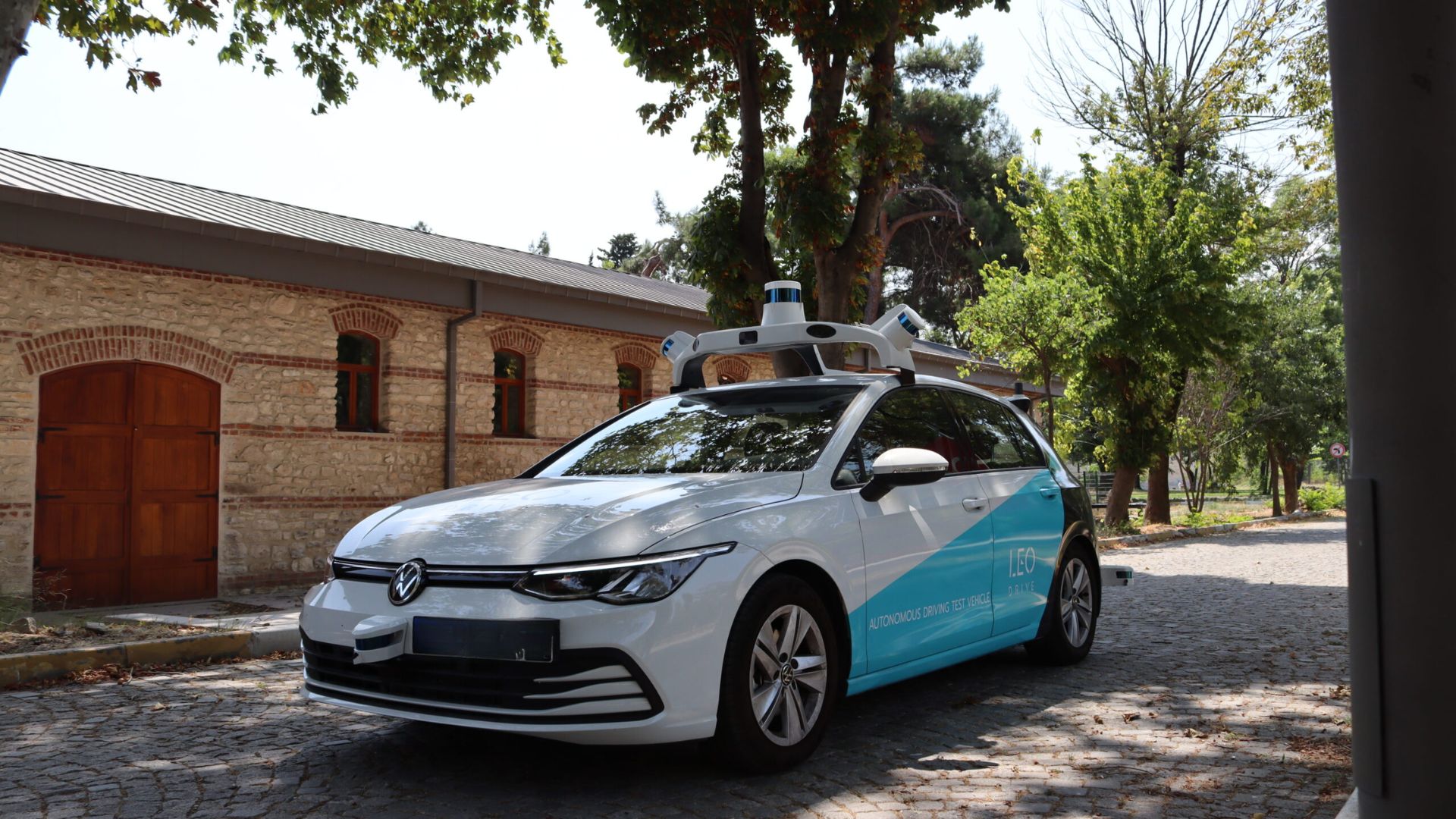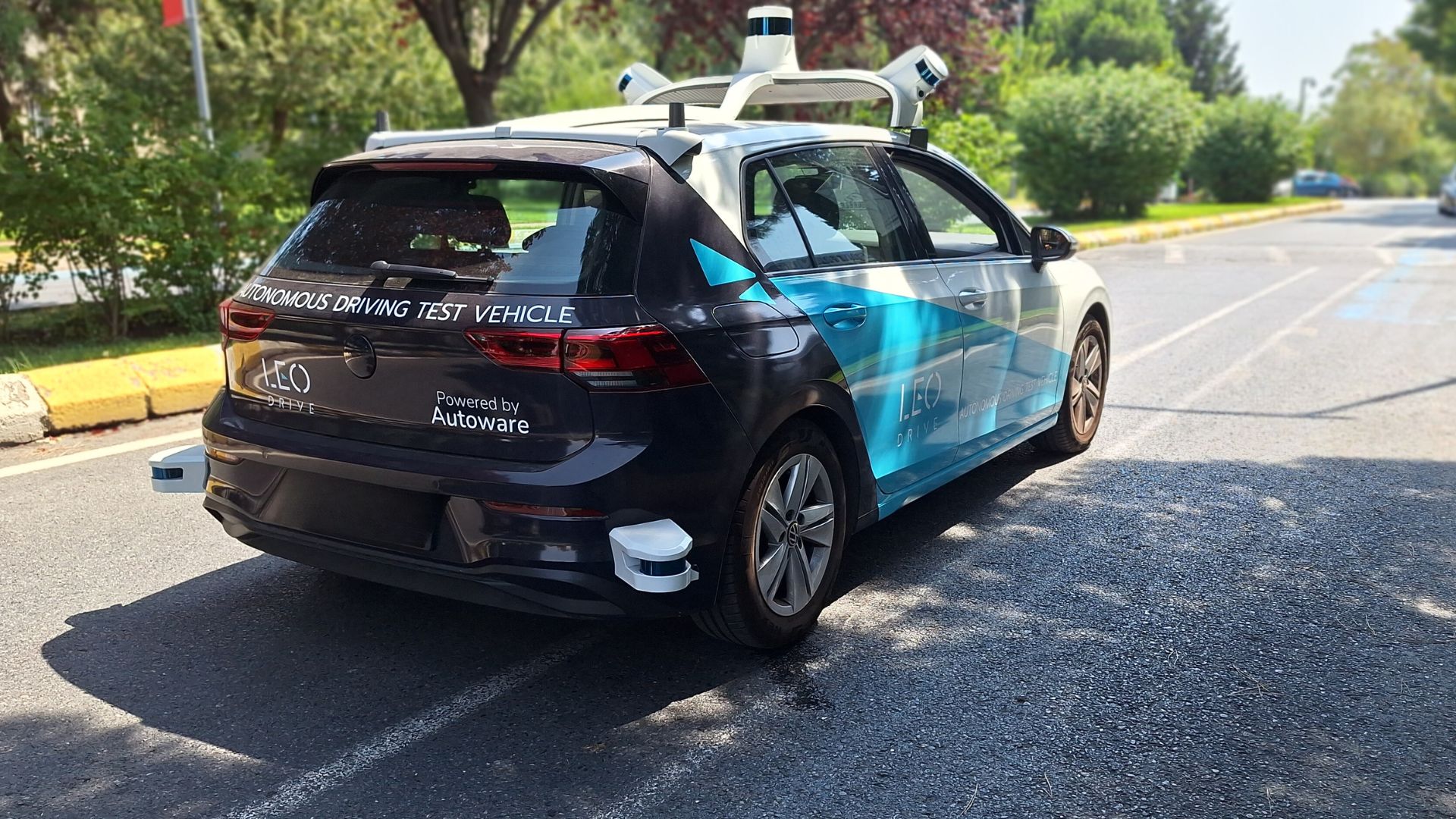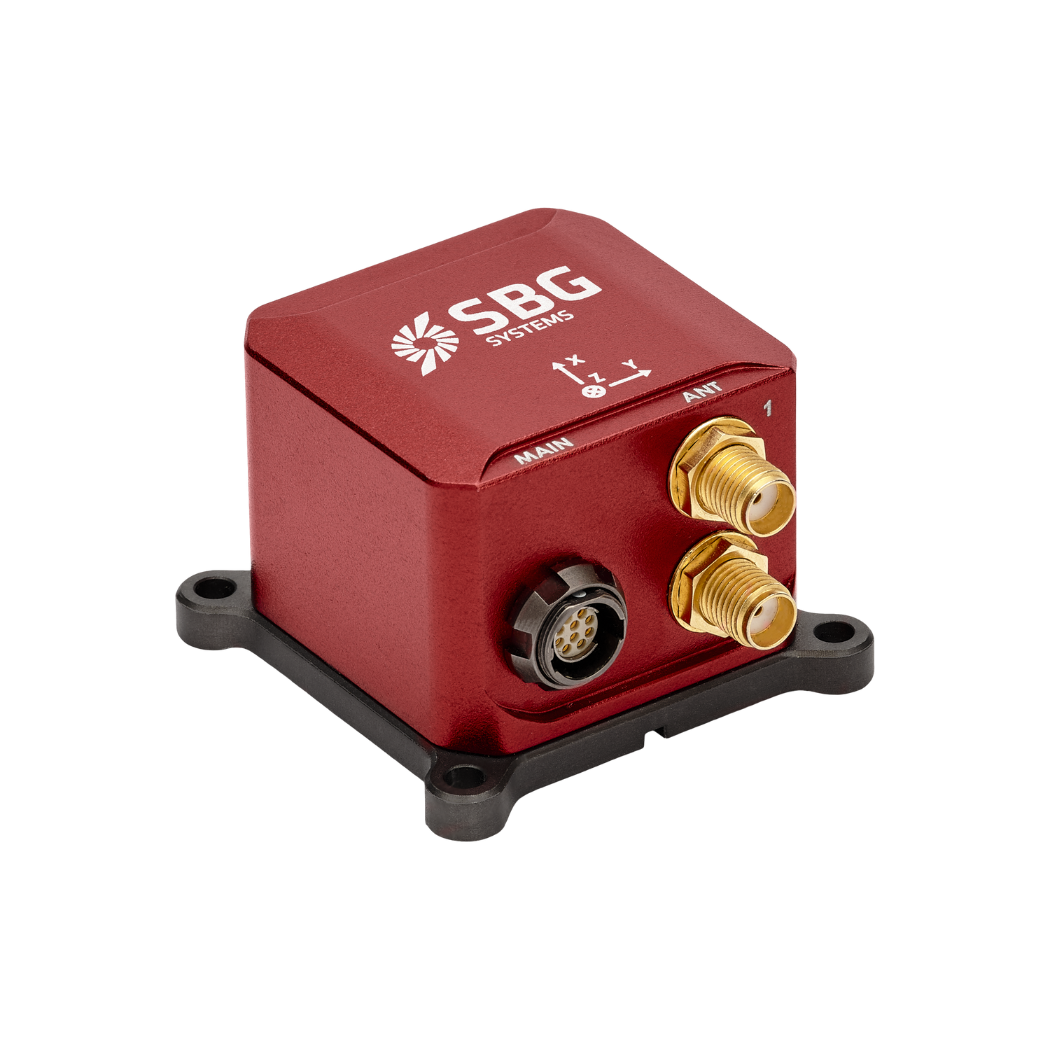Ellipse powers autonomous vehicles innovation
“Collaborating with SBG Systems and integrating the Ellipse-D into our vehicle has been essential in achieving the precision and reliability critical to our R&D efforts and autonomous operations.” | Oğuzhan Sağlam – Sales Manager
What does Leo Drive do?
Leo Drive is the leader in autonomous vehicle technology, pioneering the future of autonomous transformation.
The company specializes in providing scalable software and hardware solutions, offering an end-to-end, one-stop service for integration of autonomous systems.
Their mission is to make autonomous technology more accessible and widely adopted across various industries.
Leo Drive’s innovative approach allows their products to be adaptable and applicable to a wide range of scenarios, ensuring that autonomous technology can be seamlessly integrated into any environment.
End users of Leo Drive’s solutions span various industries, including UAVs, UGVs, and autonomous driving systems.
These users rely on the high accuracy and reliability of INS for applications such as aerial mapping, gimbal camera stabilization, and ground vehicle navigation.
Initial engagement and customer journey
Our relationship with Leo Drive began years ago, during the launch of our first Inertial Navigation System, IG-500 series.
Over the years, Leo Drive has continued to trust us for their advanced INS solutions and is now a proud partner. The trust and reliability established in the early stages of this relationship has only deepened, making our products an integral part of Leo Drive’s autonomous technology solutions.
Leo Drive’s technical requirements
Leo Drive required a high-precision inertial navigation system that could provide accurate real-time positioning and orientation data for its autonomous test vehicles. The vehicles run on Autoware software, world’s leading open source software project for autonomous driving.
Leo Drive’s key requirements included:
- Dual-antenna RTK capability: To ensure high precision in positioning and orientation.
- Reliability: Provide consistent and accurate data crucial for the safety and efficiency of autonomous operation.
- Integration flexibility: The system had to be compatible with Leo Drive’s existing platforms and robust enough to meet the demands of real-time processing in dynamic environments.
Their application and the solution offered by us
After carefully analyzing Leo Drive’s requirement, our experts recommended Ellipse-D, a dual Antenna RTK Inertial Navigation System (INS), to fulfill the localization needs.
Ellipse-D was selected for its accuracy, reliability, and advanced features, that are essential for autonomous vehicle development and testing.
Ellipse-D INS was integrated into Leo Drive’s Autonomous Test Vehicle, a passenger car converted for autonomous operations. Equipped with GNSS/INS systems, multiple cameras, and LiDAR sensors, the vehicle requires precise navigation and accurate positioning data for safe and efficient operation.
This vehicle serves as a critical platform for research and development (R&D) and technology demonstrations.

The test vehicle is powered by Autoware software, hosted by the The Autoware Foundation. It is a non-profit organization committed to the development of open source, collaborative software for autonomous vehicles.
The membership affiliation between SBG Systems and The Autoware Foundation ensures our sensors and software integrate seamlessly with Autoware’s platform, enhancing tools and resources for the autonomous vehicle community.
Integration, support, and beyond
Leo Drive mounted the Ellipse-D INS on their test vehicles using non-ferromagnetic materials to prevent interference and ensure optimal sensor performance.
The electrical connections were made via RS-232/422 and CAN interfaces, and custom drivers were used within ROS2 environment to integrate the Ellipse-D’s real-time data into their sensor fusion algorithms. The integration with Autoware platform was seamless, thanks to ROS2 Ellipse- D driver.
During the integration phase, our Support team provided ongoing assistance, quickly addressing any challenges that arose. The SBG Systems Support portal was also a valuable resource, providing comprehensive guidance and troubleshooting assistance.
Important features of Ellipse-D that played key role in Leo Drive’s Autonomous Vehicle
- Accurate positioning: Ellipse-D provides high-accuracy real-time navigation data.
- Robust orientation data: Dual-antenna RTK capabilities ensure that orientation data is reliable and supports the vehicle’s complex navigation algorithms.
- Seamless integration: The sensor’s RS-232/422 and CAN connections allowed for easy integration with Leo Drive’s onboard computers. Custom drivers and nodes in the ROS2 environment facilitated smooth communication between the Ellipse-D and other vehicle sensors, enhancing overall system robustness.
Ellipse-D exceeds expectations and meets 100% of Leo Drive’s requirements
Since integrating Ellipse-D INS into their autonomous vehicle, Leo Drive has experienced several significant improvements:
- Improved accuracy: The high accuracy in positioning and orientation provided by Ellipse-D has been instrumental in refining the performance and reliability of Leo Drive’s autonomous systems.
- Increased efficiency: Ellipse Series advanced algorithm enables smoother development processes and more accurate test results, streamlining R&D efforts.
- Timely support: The comprehensive customer support, including detailed documentation and a responsive Technical Support team, ensured a seamless integration process.
- The reliable sensor data from Ellipse-D has also been crucial for quality control, allowing Leo Drive to perform accurate tests on other sensors and further improve the overall reliability of their autonomous vehicles.
Leo Drive identified three standout qualities of SBG Systems that have been critical to their success: Exceptional customer support, high quality products, and a user-friendly support portal.
For our team at SBG Systems, working on this project with Leo Drive has been an enriching experience. We view this collaboration as a true partnership, not just a customer relationship.
Integrating the complex algorithms required for autonomous technology posed some challenges, but thanks to the dedication of our Sales, Business Development, and Algorithm teams, we were able to fully grasp and meet the technical requirements.
In the end, we’ve earned the trust of a satisfied partner in Leo Drive. Ultimately, in the navigation industry, it’s all about building reliance and trust along the way.


Ellipse-D
The Ellipse-D is an inertial navigation system integrating a dual antenna and dual frequency RTK GNSS that is compatible with our Post-Processing software Qinertia.
Designed for robotic and geospatial applications, it can fuse Odometer input with Pulse or CAN OBDII for enhanced dead-reckoning accuracy.

Ask a quotation for Ellipse-D
Do you have questions?
Welcome to our FAQ section! Here, you’ll find answers to the most common questions about the applications we showcase. If you don’t find what you’re looking for, feel free to contact us directly!
What are the autonomy levels of autonomous vehicles?
The autonomy levels of autonomous vehicles are classified into six levels (Level 0 to Level 5) by the Society of Automotive Engineers (SAE), defining the extent of automation in vehicle operation. Here’s a breakdown:
- Level 0: No Automation – The human driver fully controls the vehicle at all times, with only passive systems like alerts and warnings.
- Level 1: Driver Assistance – The vehicle can assist with either steering or acceleration/deceleration, but the human driver must remain in control and monitor the environment (e.g., adaptive cruise control).
- Level 2: Partial Automation – The vehicle can control both steering and acceleration/deceleration simultaneously, but the driver must remain engaged and ready to take over at any moment (e.g., Tesla’s Autopilot, GM’s Super Cruise).
- Level 3: Conditional Automation – The vehicle can handle all aspects of driving in certain conditions, but the human driver must be ready to intervene when requested by the system (e.g., highway driving). The driver doesn’t need to actively monitor but must remain alert.
- Level 4: High Automation – The vehicle can perform all driving tasks autonomously within specific conditions or environments (like urban areas or highways) without human intervention. However, in other environments or under special circumstances, a human may need to drive.
- Level 5: Full Automation- The vehicle is fully autonomous and can handle all driving tasks in all conditions without any human intervention. There is no need for a driver, and the vehicle can operate anywhere, under any conditions.
These levels help define the evolution of autonomous vehicle technology, from basic driver assistance to full autonomy.
How self-driving cars work?
Self-driving cars are vehicles equipped with sophisticated systems that enable them to navigate and control themselves without human intervention. These vehicles use a combination of autonomous driving sensors and algorithms to perceive their environment, make decisions, and perform self driving tasks. The goal is to achieve full autonomy, where the vehicle can handle all aspects of driving safely and efficiently.
Self-driving cars rely on an array of key technologies to perceive their surroundings. These include:
- GNSS (Global Navigation Satellite System): to get the real-time updates on the self-driving car position, speed, and direction.
- INS (Inertial Navigation Systems): to maintain accuracy in case of GNSS signal outages. It provides real-time updates on the self driving car position, speed, and direction.
- LiDAR (Light Detection and Ranging): use of laser beams to create a detailed 3D map of the vehicle’s environment. This technology helps the car detect and measure objects around it, including other vehicles, pedestrians, and road signs.
- Radar (Radio Detection and Ranging): use of radio waves to detect the speed, distance, and direction of objects. Radar is particularly useful in adverse weather conditions and for detecting objects at longer ranges.
- Cameras: to capture visual information about the vehicle’s environment, including lane markings, traffic signals, and road signs. They are essential for interpreting complex visual cues and making decisions based on visual data.
What is the difference between ADAS in cars and self-driving cars?
ADAS (Advanced Driver Assistance Systems) enhances driving safety by providing features like lane-keeping, adaptive cruise control, and automatic braking, but requires active driver supervision. In contrast, self-driving cars, equipped with autonomous driving systems, aim to fully automate vehicle operation without human intervention.
While ADAS supports drivers by assisting with tasks and improving safety, self-driving cars are designed to handle all aspects of autonomous driving, from navigation to decision-making, offering a higher level of automation (SAE levels) and convenience. ADAS characteristics or features are attributed to SAE levels below 3 and self-driving cars as such correspond to minimum level 4.
